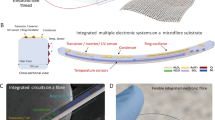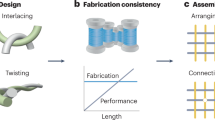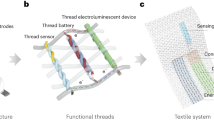Abstract
The use of organic polymers for electronic functions is mainly motivated by the low-end applications, where low cost rather than advanced performance is a driving force. Materials and processing methods must allow for cheap production. Printing of electronics using inkjets1 or classical printing methods has considerable potential to deliver this. Another technology that has been around for millennia is weaving using fibres. Integration of electronic functions within fabrics, with production methods fully compatible with textiles, is therefore of current interest, to enhance performance and extend functions of textiles2. Standard polymer field-effect transistors require well defined insulator thickness and high voltage3, so they have limited suitability for electronic textiles. Here we report a novel approach through the construction of wire electrochemical transistor (WECT) devices, and show that textile monofilaments with 10–100 μm diameters can be coated with continuous thin films of the conducting polythiophene poly(3,4-ethylenedioxythiophene), and used to create micro-scale WECTs on single fibres. We also demonstrate inverters and multiplexers for digital logic. This opens an avenue for three-dimensional polymer micro-electronics, where large-scale circuits can be designed and integrated directly into the three-dimensional structure of woven fibres.
This is a preview of subscription content, access via your institution
Access options
Subscribe to this journal
Receive 12 print issues and online access
$259.00 per year
only $21.58 per issue
Buy this article
- Purchase on Springer Link
- Instant access to full article PDF
Prices may be subject to local taxes which are calculated during checkout




Similar content being viewed by others
References
Sirringhaus, H. et al. High-resolution inkjet printing of all-polymer transistor circuits. Science 290, 2123–2126 (2000).
Service, R. F. Technology—electronic textiles charge ahead. Science 301, 909–911 (2003).
Lee, J. B. & Subramanian, V. Weave patterned organic transistors on fiber for e-textiles. IEEE Trans. Electron Dev. 52, 269–275 (2005).
Brian Farrell, P. W. N., Teverovsky, J., Slade, J. & Powell, M. Method of manufacturing a fabric article to include electronic circuitry and an electrically active textile article. US patent 6,729,025 (Foster-Miller, USA, 2001).
E. Rehmi Post, N. G. Method of making flexible electronic circuitry. US patent 6,493,933 (Massachusetts Institute of Technology, USA, 2000).
Kuhn, H. H., Child, A. D. & Kimbrell, W. C. Toward real applications of conductive polymers. Synth. Met. 71, 2139–2142 (1995).
Hong, K. H., Oh, K. W. & Kang, T. J. Preparation and properties of electrically conducting textiles by in situ polymerization of poly(3,4-ethylenedioxythiophene). J. Appl. Polym. Sci. 97, 1326–1332 (2005).
Carpi, F. & De Rossi, D. Electroactive polymer-based devices for e-textiles in biomedicine. IEEE Trans. Inform. Technol. Biomed. 9, 295–318 (2005).
Maccioni, M., Orgiu, E., Cosseddu, P., Locci, S. & Bonfiglio, A. Towards the textile transistor: Assembly and characterization of an organic field effect transistor with a cylindrical geometry. Appl. Phys. Lett. 89, 143515 (2006).
Johansson, T., Pettersson, L. A. A. & Inganas, O. Conductivity of de-doped poly(3,4-ethylenedioxythlophene). Synth. Met. 129, 269–274 (2002).
Nilsson, D. et al. Bi-stable and dynamic current modulation in electrochemical organic transistors. Adv. Mater. 14, 51–54 (2002).
Mabeck, J. T. et al. Microfluidic gating of an organic electrochemical transistor. Appl. Phys. Lett. 87, 013503 (2005).
Nilsson, D., Robinson, N., Berggren, M. & Forchheimer, R. Electrochemical logic circuits. Adv. Mater. 17, 353 (2005).
Andersson, P. et al. Active matrix displays based on all-organic electrochemical smart pixels printed on paper. Adv. Mater. 14, 1460 (2002).
Daoud, W. A., Xin, J. H. & Szeto, Y. S. Polyethylenedioxythiophene coatings for humidity, temperature and strain sensing polyamide fibers. Sensors Actuators B 109, 329–333 (2005).
Crispin, X. et al. The origin of the high conductivity of poly(3,4-ethylenedioxythiophene)- poly(styrenesulfonate) (PEDOT-PSS) plastic electrodes. Chem. Mater. 18, 4354–4360 (2006).
Robinson, N. D., Svensson, P. O., Nilsson, D. & Berggren, M. On the current saturation observed in electrochemical polymer transistors. J. Electrochem. Soc. 153, H39–H44 (2006).
Nyberg, T., Inganas, O. & Jerregard, H. Polymer hydrogel microelectrodes for neural communication. Biomed. Microdev. 4, 43–52 (2002).
Herland, A. et al. Electroactive luminescent self-assembled bio-organic nanowires: Integration of semiconducting oligoelectrolytes within amyloidogenic proteins (vol 17, pg 1466, 2005). Adv. Mater. 17, 1703 (2005).
Acknowledgements
These investigations were financially supported by the Centre of Organic Electronics (COE) at Linköping University, Sweden, financed by the Strategic Research Foundation SSF. We thank W.-Y. Lin for electrical measurements on single WECTs and monofilaments, M. Asplund for discussions and K. Hamedi for graphic design. Textile fibres were kindly donated by Shakespeare, UK, and IFP Research, Mölndal, Sweden.
Author information
Authors and Affiliations
Contributions
M.H. carried out experiments. R.F. contributed to development of the logic design. O.I and M.H. wrote the manuscript. M.H., O.I. and R.F contributed to project planning.
Corresponding author
Ethics declarations
Competing interests
A patent application on this technology has been submitted by the authors.
Supplementary information
Supplementary Information
Supplementary figures 1S and 2S (PDF 414 kb)
Rights and permissions
About this article
Cite this article
Hamedi, M., Forchheimer, R. & Inganäs, O. Towards woven logic from organic electronic fibres. Nature Mater 6, 357–362 (2007). https://doi.org/10.1038/nmat1884
Received:
Accepted:
Published:
Issue Date:
DOI: https://doi.org/10.1038/nmat1884
This article is cited by
-
Woven organic crystals
Nature Communications (2023)
-
Smart textiles for personalized healthcare
Nature Electronics (2022)
-
ZnO-TiO2 hybrid nanocrystal-loaded, wash durable, multifunction cotton textiles
Cellulose (2022)
-
Recent progress of fiber-based transistors: materials, structures and applications
Frontiers of Optoelectronics (2022)
-
Smart textile lighting/display system with multifunctional fibre devices for large scale smart home and IoT applications
Nature Communications (2022)



